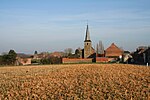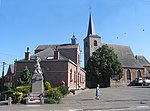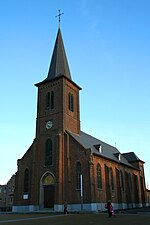Estinnes
Hainaut geography stubsMunicipalities of Hainaut (province)Pages including recorded pronunciationsPages with French IPA

Estinnes (French pronunciation: [ɛstin] ; Picard: L' Estene) is a municipality of Wallonia located in the province of Hainaut, Belgium. On 1 January 2006 Estinnes had a total population of 7,413. The total area is 72.73 km2 which gives a population density of 102 inhabitants per km2. The municipality consists of the following districts: Croix-lez-Rouveroy, Estinnes-au-Mont, Estinnes-au-Val, Faurœulx, Haulchin, Peissant, Rouveroy, Vellereille-les-Brayeux, and Vellereille-le-Sec. Estinnes was the location, on 1 March 744, of the second reform council organized by Saint Boniface.Near Estinnes is a wind farm with 11 wind turbines of Enercon E-126 type, 198.5 metres (651 ft) high.
Excerpt from the Wikipedia article Estinnes (License: CC BY-SA 3.0, Authors, Images).Estinnes
Rue Grande, Estinnes
Geographical coordinates (GPS) Address Nearby Places Show on map
Geographical coordinates (GPS)
| Latitude | Longitude |
|---|---|
| N 50.4 ° | E 4.1 ° |
Address
Rue Grande
Rue Grande
7120 Estinnes
Hainaut, Belgium
Open on Google Maps










